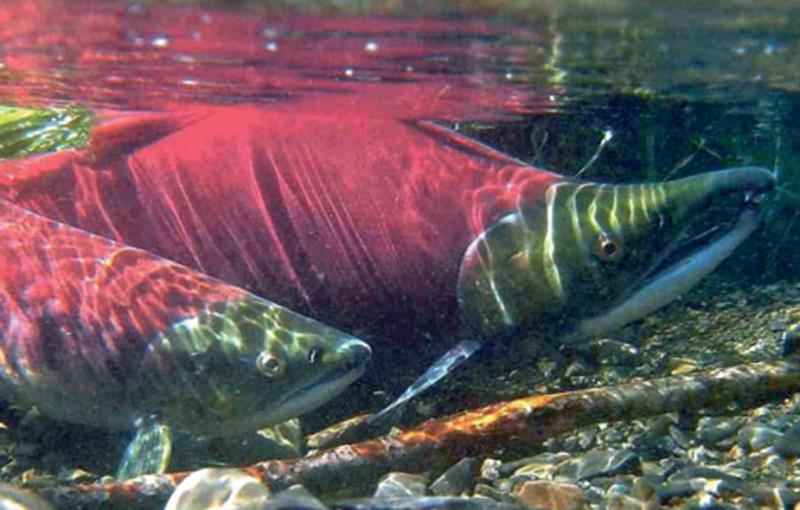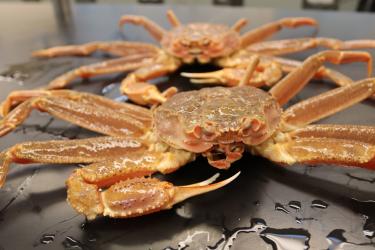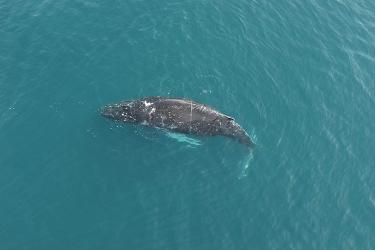The world’s largest run of sockeye salmon begins in Bristol Bay river systems that flow into the Bering Sea. There young salmon face a crucial bottleneck: they must find good food and conditions so they can store enough fat to survive their first winter at sea. Understanding how climate drives survival during this critical life stage is key to predicting future salmon returns in a rapidly changing ecosystem.
A new study explores how climate influences survival of salmon—both directly through temperature, and indirectly through cascading effects on their food. Researchers looked at shifts in distribution and abundance of juvenile sockeye salmon in the Bering Sea in relation to temperature, prey, and competitors. The 17-year study (2002–2018) encompassed warm and cool conditions. The findings will help scientists more accurately predict future change to inform sustainable management and help fishing communities prepare for the future.
“Understanding how young salmon and their prey responded to past ecosystem change gives us a clue to what will happen in the future,” said study leader Ellen Yasumiishi, NOAA Fisheries biologist, Alaska Fisheries Science Center. “We want to know what’s driving the number of salmon returns so we can give fishermen an early outlook on what to expect.”
Salmon in a Warming Bering Sea
Climate change is rapidly and dramatically transforming the Bering Sea ecosystem. As the ocean warms, many marine species are on the move, seeking suitable habitat. Bristol Bay sockeye salmon, at the northern reach of the species’ range, have flourished with recent warming.
Pacific salmon such as sockeye support important commercial, subsistence, and recreational fisheries in Alaska. They play an important role in local culture and a complex role in the ecosystem. Predicting future climate-driven change is critical for developing sustainable management plans and helping fishing communities prepare for the future.
The eastern Bering Sea is an important nursery ground for juvenile Bristol Bay sockeye salmon. To predict how climate change may affect Bristol Bay salmon runs in the future, we need to understand how climate drives survival of young salmon during their critical first summer in the Bering Sea.
Previous studies show that since 2000, young sockeye salmon abundance has increased in the Bering Sea. They moved to the north and west, and their diets differed between warm and cold years.
“To understand how Bristol Bay sockeye salmon may respond to future climate change, we need to understand the mechanisms by which climate impacts them,” Yasumiishi said. “We need to know why their distribution, abundance, and diet shifted.”
Tracking Climate-Driven Shifts in Salmon and Prey
Researchers from NOAA Fisheries Alaska Fisheries Science Center and University of Alaska Fairbanks collaborated to begin to answer these questions.
Study data were collected during Alaska Fisheries Science Center Bering Arctic Subarctic Integrated Surveys. These surveys took place in late summer in the eastern Bering Sea. The sampling period covered years of relatively warm (2002–2005), cool (2006–2013), warm (2014–2018), and exceptionally warm (2016) ocean conditions. This period of warm-cool-warm stanzas offered the opportunity to see how salmon and prey responded to various climate conditions.
Across these years, the team compared the distribution and abundance of juvenile sockeye salmon in relation to prey, competitors, and sea surface temperature. They also examined diets of juvenile sockeye salmon.
“Together these data let us look at variations in salmon and their food over space and time and under different climate conditions,” Yasumiishi said. “That gives us a picture of how climate drives change directly through temperature and indirectly through its influence on prey."
The research produced some unexpected results.
Distribution
- Juvenile sockeye salmon distributed in warmer waters, except during the exceptionally warm year of 2016
- No correlation with large copepods—high-fat zooplankton known to be prey of both juvenile sockeye and young pollock, a minor prey for sockeye
- Juvenile sockeye distribution shifted with that of juvenile pink salmon, a potential competitor: high concentrations of these species were found together
- Densities of juvenile sockeye and juvenile Alaska pollock, a primary prey, were positively related
Abundance
- Juvenile sockeye salmon were more abundant in years with more age-0 pollock and juvenile pink salmon
- Juvenile sockeye salmon abundance had a nonlinear relationship with average summer sea temperature, where 2016 was too warm
- Fewer juvenile sockeye were seen in 2016, an exceptionally warm year
“We were surprised that large copepods didn’t seem to be guiding the distribution of juvenile sockeye,” Yasumiishi said. “Were there enough copepods to feed on even where they were in lower numbers? Or were juvenile sockeye seeking pollock or krill instead?”
Juvenile sockeye diet analysis revealed further information. Juvenile sockeye ate mainly young pollock, especially in warm years. During cold years, other fish and krill were important prey. Large copepods were not the primary prey in any of the study years.
“It was really cool to see the patterns of juvenile sockeye shifting positively with young pollock,” Yasumiishi said. “Maybe a preferred prey is driving the survival of juvenile sockeye salmon.”
Forecasting Future Change
Long time series such as those collected during surveys are our best tool for observing and predicting effects of climate change. Alaska Fisheries Science Center shares these data with our partners through regular Ecosystem Status Reports on ocean conditions. We also share data on young fish condition and abundance with the University of Alaska, North Pacific Fisheries Management Council, and regional subsistence advisory councils.
Results of this study provide a step toward development of forecast models for use in management of federal groundfish and Alaska state salmon fisheries.
“The next step would be to age these fish and use genetics to find out where they were born—where we expect them back,” Yasumiishi said. “With that information we will be able to directly predict returns. We will be able to give fishermen an early outlook on what to expect 2 to 3 years later.”
Yasumiishi intends to watch for new interactions that young sockeye salmon may encounter as the ecosystem continues to transform.
“Until now young salmon and pollock have been the primary small fish in the southeast Bering Sea. Herring and capelin have been dominant in the north,” Yasumiishi said. “If sockeye and pollock continue to move north, it will be interesting to see what happens when they start hanging out together. Will they compete for food?””









